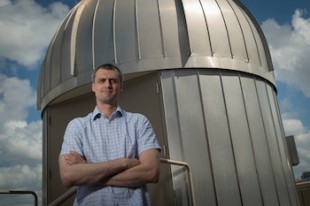Rice U.’s Bradshaw is building model for mechanism that creates sun’s ultra-hot corona
Stephen Bradshaw, a Rice University assistant professor of physics and astronomy, has won a prestigious National Science Foundation CAREER award to advance his research into the mechanisms of the sun’s atmosphere.
Bradshaw will receive around $700,000 in research funding over the five-year span of the award, which goes to junior faculty members “who exemplify the role of teacher scholars.” The awards are among the foundation’s most competitive.
Bradshaw, who joined Rice in 2010, will focus on the creation of computational models that explain why the sun’s outer atmosphere, the corona, is as much as 1,000 times hotter than the surface and how it acquires the vast amounts of energy that make it so.

Stephen Bradshaw has won a five-year CAREER research grant from the National Science Foundation. Photo by Jeff Fitlow
“If you think about moving away from a source of heat like the sun, it should get colder,” he said. “And that happens in the interior, from the core to the surface: The temperature drops as you’d expect. But once you get to the surface of the sun and start going up into the atmosphere, the temperature suddenly rises again.
“This is kind of weird. And it’s not just a little bit: It goes from 6,000 to 2-3 million kelvins. It’s not just an anomaly. One of the things I’ve spent my career on is trying to understand how this can be.”
Current thought, he said, is that magnetic fields, which carry an enormous amount of energy from the surface of the sun, can heat pockets of low-density plasma in the corona in as little as a few seconds. Such rapid heating should theoretically lead to radiation from strongly charged ions, but they lag behind the temperature change in adjusting their charge states. This radiation, which solar researchers are only just beginning to see with modern instruments, is a marker for super-hot plasma.
“This emission is very faint because the ion populations are so small, so it’s hard to detect. But our new instruments are better and more sensitive, and we’re looking in the right places,” said Bradshaw, who is also the William V. Vietti Junior Chair of Space Physics at Rice.
He said the low-density plasma at extreme temperatures is “in a completely different regime of physics to what we’re used to dealing with. There’s a lot you need to consider and account for to be able to understand it properly.”
Part of the new grant will help develop more sophisticated models by which researchers can understand the data from a new generation of solar instruments, including a proposed X-ray detector called the Marshall Grazing Incidence X-ray Spectrometer. Bradshaw expects NASA to launch it on a suborbital flight.
“It will look at individual spectral lines in the X-ray region that are emitted by exactly the very hot plasma I’m interested in modeling,” he said. “Spectral lines can tell us about the content of the plasma, how fast it’s flowing toward or away from us and how hot the ions are compared with how hot the electrons are.”
Other new instruments include one that will fly a polar orbit around the sun and another that will fly into its atmosphere, returning as much information as possible before burning up. All of the experiments will help gather the enormous amount of data Bradshaw will need to validate models he hopes will incorporate the entire thermal structure of the sun’s atmosphere.
“This makes the computational problem vastly more difficult and time-consuming,” he said. “So with this award we’re developing more sophisticated physics to treat ionization states and the transport of energy through the plasma in a hopefully more accurate and realistic way.”
Bradshaw is making use of and helping develop new supercomputer systems at Rice to handle the load. He is a co-principal investigator on BIRD Cloud, a system that will offer Rice researchers a way to compute in the cloud with fewer barriers. He also expects to make extensive use of the DAVinCI supercomputer and its Visualization Wall. Both systems are administered by Rice’s Ken Kennedy Institute for Information Technology.
The CAREER grant includes funds for educational outreach as well. Bradshaw is putting together a summer school for rising juniors and seniors in the Houston Independent School District who are interested in pursuing careers in science, technology, mathematics or engineering (STEM). He expects the program will begin in 2016.
Bradshaw is also part of the newly formed Laboratory for Space and Astrophysical Plasmas at Rice, which brings the university’s space physics initiatives under one banner.
“All of Rice’s facilities like BIRD Cloud and DAVinCI are going to facilitate this research, and the university’s expertise in education and curriculum development will facilitate the educational component,” he said.
“This is going to keep me busy for a lot longer than the five-year duration of the award. There’s going to be a lot of new knowledge that comes out of this.”


Leave a Reply